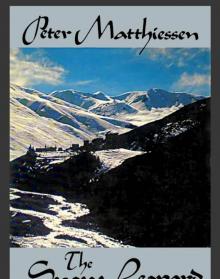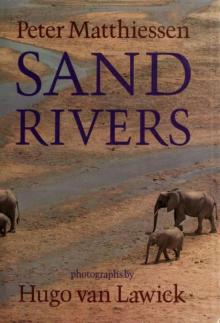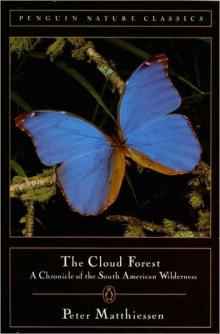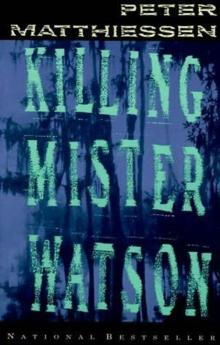- Home
- Peter Matthiessen
The Cloud Forest Page 10
The Cloud Forest Read online
Page 10
Through this taxing period our peril, if any, was increased, to my mind, by the presence in the pilot’s cabin of a big, saucy German girl. On the ground at Caihaique she had won the hearts of the chileno airmen, who were half her size, and was invited to pass the remainder of her journey in the cockpit. I don’t say she was at the controls, but it may have been some gallant attempt to win her admiration which shook my easily shaken confidence in the Latin fliers.
The indecision was most pronounced over Lake Buenos Aires, a magnificent blue water saddling the Andes of both Chile and Argentina, stretching east and west for more than one hundred miles. In the swift clouds one saw two almost identical fields of blue, one of these being the sky and the other—not always the lower one, either—the lake. It was difficult to concentrate on it, though, for here the wind had reached its zenith, and the plane was doing some spectacular gyrations. Then suddenly it swung, or was blown off, to the eastward, descending rapidly at a steep incline, and the steward came down the aisle saying “No fumar, no fumar—no es-moking!” This struck me as an unnatural request, there not being a landing field for a hundred miles, much less a good reason to land. I didn’t have the pluck to request an explanation, though. And after a time the wind, plane, and pilot calmed a little, and we headed south again across the barrens of Argentine Patagonia. We had not regained altitude, and while at times we were skimming the plateaus at no more than a few hundred feet, this unusual tactic enabled me to get a better look at a wild country I had come far to see.
Patagonia—loosely, “land of giant feet”—was named by the small Spaniards in honor of the large footprints of the Indians; the Tehuelches, especially, were very tall, many of the men being six feet four inches and more. While the name Patagonia is sometimes used to describe all of South America south of the thirty-ninth parallel, including the Andes and the Chilean Archipelago, it signifies more exactly the great treeless barrens on the Atlantic slope of the mountains, from the Argentine Pampa south to the hook of the Andes, including those parts of Chile on the eastern shores of the Strait of Magellan and most of Tierra del Fuego.
North of the Strait, Patagonia is extremely desolate, far more so than one expects. Between Lake Buenos Aires and Cardiel the bare plateaus of the western foothills support only a thin grass and the poorest sort of ground scrub, though gradually, as we move southward, some tundra ponds and sterile-looking creeks appear, supporting a wan green along their edges. On this wind-swept day of swarthy clouds and sun, the view across this wasteland to the receding mountains is oppressive. Far off beneath the snows, another huge lake, Argentino, spreads away. The land rises and falls more gently now, so monotone and lifeless that one has the impression—not inaccurate, from a geological point of view—of the floor beneath the sea.
The Santa Cruz River, green-silver and snaky, starts east across the desert toward the Atlantic; then a high, grassy plateau, an island in the waste, and here there are several bands of dark horses, never more than eight together; one band runs wildly, black manes flowing, at the low passage of the plane. There have been wild horses in Argentina since the early sixteenth century, when, as in North America, a few escaped the Spanish, but they are shot down commonly by the ranchers and are growing rare now except in these deserted regions. There are also small bands of a lesser, light-colored animal: these must be that small wild camel, the guanaco, though I cannot be certain, even with binoculars. However, they are far from any road or sign of man, and neither their color—a pale brown—nor their small numbers suggest sheep.
The land descends and softens. Here is Lago Blanco, accurately named; we have crossed the frontier again, into Chilean Patagonia. To the west spreads slowly what looks like another of the great blue lakes which stretch across the Andes, but its blue is deeper, colder. This is Otway Inlet, a long arm of the sea, which comes in from the Pacific reaches of the Strait of Magellan. The eastern straits are visible far ahead, and in a little while the plane curves out over the water; Punta Arenas, the most southerly city in the world, gleams in a weak sun down the coast. Across the water, some twenty miles or more, is the purple shadow of Tierra del Fuego.
February 2–4.
The area comprising south Patagonia, the Strait, the islands and channels, and Tierra del Fuego is sometimes called Magallanes, and it has been vividly described by numerous writers, among whom Captain Joshua Slocum, Richard Henry Dana, and Charles Darwin are among the best known. Dana, in his preface to Two Years Before the Mast, expresses a certain doubt about the need for his book: “… there have been so many stories of sea life written, that I should really think it unjustifiable in me to add one to the number without being able to give reasons in some measure warranting me in so doing.” I feel somewhat the same in attempting, for example, to give an impression of the notorious Strait, which Captain Slocum, passing through at this same time of year, in 1896, took more than two months to navigate. He was alone in a small sloop, the Spray, and his perspective was somewhat different from that of an adventurer like myself, who gazes fearlessly upon these ferocious waters—they are calm at the moment and were calm yesterday—from the window of my room in the Hotel Cosmos. And this, I suppose, must be my justification, that mine is a fresh approach.
Punta Arenas, first of all, is a center for the scattered oil, coal, and ranching industries of the region, is developing a silver-fox farm, and is also a free port; these are the reasons for its surprising size and relative prosperity. It is a bare, airy place—for the prevailing wind out of the southwest is almost constant—and pleasant enough during the summer season, though unless one is here on business it hasn’t a great deal to recommend it. Like many towns in South America, however, it can boast an interesting regional museum; this I visited on the afternoon of my arrival. The museum, maintained by Silesian missionaries, has fine collections of preserved fauna, including the eskimo curlew, now extinct; this bird once migrated as far as Patagonia from its nesting grounds in Canada. (The Punta Arenas specimen is rather startling at first, until one sees that it was given bright blue eyes by its unknown taxidermist.) There are also two enormous cougars, nearly the size of lionesses; my impression had been that the mountain lions of South America were much smaller than our own. But the most interesting displays are of the artifacts of the Fuegian Indian tribes, among which only the Alacalufes of the outer channels of Chilean Magallanes, to the southwest, still exist. Like the Yahgans, who inhabited formerly the eastern channels and south shores of the main island of Tierra del Fuego, the short-legged Alacalufes pass the great part of their lives in their rough canoes and go virtually naked in a world of sea and granite celebrated for wind and cold. The Yahgans, in fact, were described by Darwin as the most primitive people on earth, and his own descriptions tend to bear him out:
While going one day on shore near Wollaston Island, we pulled alongside a canoe with six Fuegians. These were the most abject and miserable creatures I anywhere beheld. On the east coast the natives [i.e., the Onas] … have guanaco cloaks, and on the west [i.e., the Alacalufes], they possess seal-skins…. But these Fuegians in the canoe were quite naked…. These poor wretches were stunted in their growth, their hideous faces bedaubed with white paint, their skins filthy and greasy, their hair entangled, their voices discordant, and their gestures violent. Viewing such men, one can hardly make oneself believe that they are fellow-creatures, and inhabitants of the same world.
According to Darwin, the Yahgans subsisted on shellfish, carrion, and fungus except on special occasions, when they enjoyed the flesh of captured enemies or of old decrepit women in their own tribe. Unlike most Indian tribes, they were brutal and treacherous even before they were disillusioned by the white man, and, throughout their brief recorded history, rewarded all efforts to better their lot with theft and massacre. Darwin’s party returned to their homeland three Fuegians previously taken to England for the edification of the royal family; after three years’ exposure to civilization, two of these reverted almost immediately to their former ways
, making off for parts unknown with all the belongings of the third, a man called Jemmy Button. Some hope, however, was held out for the latter: “Everyone must sincerely hope that Captain Fitz Roy’s noble hope may be fulfilled, of being rewarded for the many generous sacrifices which he made for these Fuegians, by some shipwrecked sailor being protected by the descendants of Jemmy Button and his tribe!” But unhappily, as I was to learn subsequently in Tierra del Fuego, this modest ambition proved to have been in vain.
While in Punta Arenas I was taken some miles out along the coast to see an extraordinary rock garden, Las Robles, developed by members of the Campos-Menendez family, who were very hospitable to me in Punta Arenas and in Tierra del Fuego. Garden flowers of all colors, in a variety and profusion unimaginable in this climate, have been encouraged to grow on a steep bank of the Strait protected from the prevailing wind. The interest and beauty of the place were much increased by an adjoining garden of regional plants and trees, including the thorny calafate, the common shrub of Patagonia, and the two varieties of “beech.” (These are Nothofagus pumilio and N. antarctica, both called roble, or oak. N. pumilio looks rather like the North American live oak but is actually identical with the Australian beech. This is the common tree of the Fuegian rain forests, and the fact that it is indigenous only here and in Australia gives one a strong sense of time and change on the earth’s face.) There were also wild anemones, verbena, a variety of ferns, the Fuchsia magellanica, and the faithful diente de león, or lion’s tooth—the common dandelion.
The weather today is back to normal—this is to say, blowing a gale. (Despite traditional reports to the contrary, the wind blows hardest here in summer. This is very fortunate, for this wind, in combination with the intense cold of winter, would make life in these regions almost insupportable.) The color of the Strait is largely white, and the small cargo sloop, the Gaviota, on which I had hoped to cross today to Tierra del Fuego, will not venture out. In consequence, I took a walk this morning out onto the sandy point for which the town is named; Captain Slocum, in fact, referred to it unabashedly as Sandy Point. The beach is dark and gravelly, littered with garbage, and in this respect, as well as in its wintry aspect and the sharp bite of its summer wind, is rather like its northern counterpart at Point Barrow. As far out as binoculars can reach, the Strait is alive with birds: large white-fronted cormorants, black-mantled kelp gulls, the small brown-hooded gull, South American terns with crimson bill, and the hulking cinnamon skua; I last saw this bird, or rather its near relation, in the North Atlantic in November. A small flock of the white Magellan rock goose passes along the beach, and there are ducks bobbing far offshore. Beyond them, slicing down-wind on long, stiff wings, sails the black-browed albatross; this majestic bird is the first albatross I have ever seen. I search also for the Magellan penguin and for the small diving petrel, but they are nowhere to be found in the rough water.
Behind the beach, in a bleak lagoon, more terns, gulls, and skuas face the wind, and with them on the mud flats a large flock of white-rumped sandpipers and some snowy plovers; both these latter species, like the eskimo curlew and other shore birds, migrate here from their nesting grounds in North America. On the beach itself lies a varied sea wrack. There are shells of mussels and limpets, both of these uncommonly large, a pretty striated snail, a round white clam, some dead isopod crustaceans, strands of the mighty sea kelp, bits of petrified wood, a dead cat, and a dead dog. And toward the end of the morning there appeared a school of large swift dolphins, hunting along the beach. When swirling through fish, these animals would surge half out of the water; they are called Commerson’s dolphins, I believe, white beneath, with a white oblong patch behind the dorsal.
Though the wind was as stiff as ever, the Strait had grown much calmer—presumably the tide was now running with the wind rather than against it—and I kept searching the far coast for a sign of the Gaviota. But there is no sign of her, and I shall be here at least until tomorrow. This, of course, is one of the drawbacks of travel in out-of-the-way places, that travel is at best uncertain and one is often stranded for three or four days at a time.
February 5.
The winds in the Strait of Magellan are extremely unpredictable. The early morning was calm and windless, and then suddenly, without warning, a wind was skipping across the pier where the Gaviota was unloading her bales of wool. In a matter of minutes the harbor was seething with a short, high chop. After taking aboard some barrels of wine and pickled food, we set off in this weather for Porvenir, on the Chilean coast of Tierra del Fuego. The Gaviota is equipped with a slow motor, but, once clear of her berth, she hoisted a heavy mainsail of brown canvas. Though we were running under power before the wind, the sail immediately bellied taut, increasing her speed to a respectable eight knots and serving as a steady sail as well. For the first two hours she spanked along like an America’s Cup contender, only to plough to a near halt when, quite as swiftly as it had come, the wind dropped out again; an hour later, near Porvenir, the wind returned, stronger than before, but by the time we disembarked, it had collapsed.
As one crosses the Strait, the snow-touched peaks of the Brunswick Peninsula are dominant in the west, and to the south, Dawson Island and the mouth of Useless Bay. Albatross wheel across the wind, wings stiff as boomerangs, and the strange diving petrels flee our bows, fluttering away across the chop. Overhead, the faint shrieks of a tern, which two skuas are pirating of its catch; it is amazing how agile the dark, bulky skuas can be. (This species, unlike most, is scientifically well named: Megalestris chilensis may be freely translated as “big Chilean pirate ship.”) The swift tern cannot shake them off, and finally, so high now that it can no longer be heard, is forced to drop its minnow. The skuas fold their wings and drop like stones, but both swoop up at the last minute, having lost their catch in the rough water.
The Gaviota is besieged by a school of the flashing dolphins observed yesterday; they charge the bow, duck beneath, leap, whirl, swim upside down—I have never seen such a dolphin show in all my life, and they move so fast that, on the surface; they throw up a high, curling slice of water as they go. They stay with us for twenty minutes or more, fooling along the hull: though they circle the boat with ease, their flukes, even at close range, betray scarcely a motion. They move smoothly as projectiles.
The coast of Tierra del Fuego is dark behind cold white walls of fine rain; these are characteristic, apparently, of certain weather. The rains are separate and look like smoke, but are not the reason for the island’s name. The fires seen by Ferdinand Magellan in 1520 were almost certainly signal fires of the Alacalufes, which were often built on mounds of earth in the crude hollow-log canoes.
Long strings of cormorants move up and down the coast, and a flock has gathered near the mouth of Porvenir Inlet. The inevitable German is aboard, this one a Chilean native, and he claims to have seen five Magellan penguins a few minutes before. These birds have eluded my binoculars, though at the moment he speaks of, I must confess, I had crept in out of the cold rain for a cigarette. The rain in Magallanes is as treacherous as the wind and falls often when the sun is shining.
Porvenir Inlet is a natural harbor and a pretty one, in terms of the barren landscape. The coast here is low and flat, and the mountains are visible far away in the background. The water is speckled with cormorants and ducks, including the great, heavy pato vapor, or “steamboat duck,” which is flightless and moves swiftly over the surface, using its wings as paddles. (The two species of pato vapor are the least famous of the three types of flightless birds in this part of the world, the other two being the penguins and the rhea, or South American ostrich.) The crewmen of the Gaviota are firing at the birds with a .22, but they are poor shots; I am particularly glad of this a moment later when one of them, carried away, starts shooting at a dolphin. Shooting at live things with a .22 rifle—whether they are edible or even retrievable is a matter of no importance—is considered terrific sport in South America and, as the wildlife of the continent grows
scarcer, will become more and more important in the inevitable extinctions.
I carried my bags up into the village and located some late lunch and a bed in a small pensión; though the place was without running water and featured a grim outhouse in the backyard, its cleanliness was exemplary for these parts, and the kindly owner, Señora Candellaria del Gallardo, should probably be congratulated; whatever else may be said, she has been of more help to wayfarers than Jemmy Button and his tribe. In the afternoon I inspected the huge bales of sheep wool awaiting shipment on the dock, then walked out along the harbor. Shore birds were everywhere—sandpipers, oystercatchers, Hudsonian curlews, the lovely red-breasted winter plover, and the ubiquitous teros, or lapwings. The latter, with their crest and striking pattern, are very handsome, but their loud, constant cries are the only voice in the bird world which I have found actually offensive—in fact, their persistence drove me inland. Climbing some low, bushy banks, I found myself in open country and walked out through the thinning shrubs of the coastline onto the Patagonian plain.
The flowers in bleak places always seem the most welcome of all, and today their colors are quite startling against the olive monotones which stretch away beneath the clouds. A yellow flower rises smartly in tall, bushy clumps, and there are white and bright blue flowers like asters, and the good old diente de león. Also, some delicate ground ferns and lichens, and a kind of red crowberry. All these are sheltered among low bushes, of which the most prominent is the thorny calafate. Fluttering busily here and there are song sparrows with orange napes, and a tiny black and rufous bird, unusually tame; this is the red-backed ground tyrant, one of the many flycatchers in South America.

 Lost Man's River: Shadow Country Trilogy
Lost Man's River: Shadow Country Trilogy The Tree Where Man Was Born
The Tree Where Man Was Born The Snow leopard
The Snow leopard Sand Rivers
Sand Rivers The Cloud Forest
The Cloud Forest Sal Si Puedes (Escape if You Can)
Sal Si Puedes (Escape if You Can) Far Tortuga
Far Tortuga Men's Lives
Men's Lives On the River Styx: And Other Stories
On the River Styx: And Other Stories Shadow Country
Shadow Country At Play in the Fields of the Lord
At Play in the Fields of the Lord Lost Man's River
Lost Man's River Killing Mister Watson
Killing Mister Watson On the River Styx
On the River Styx